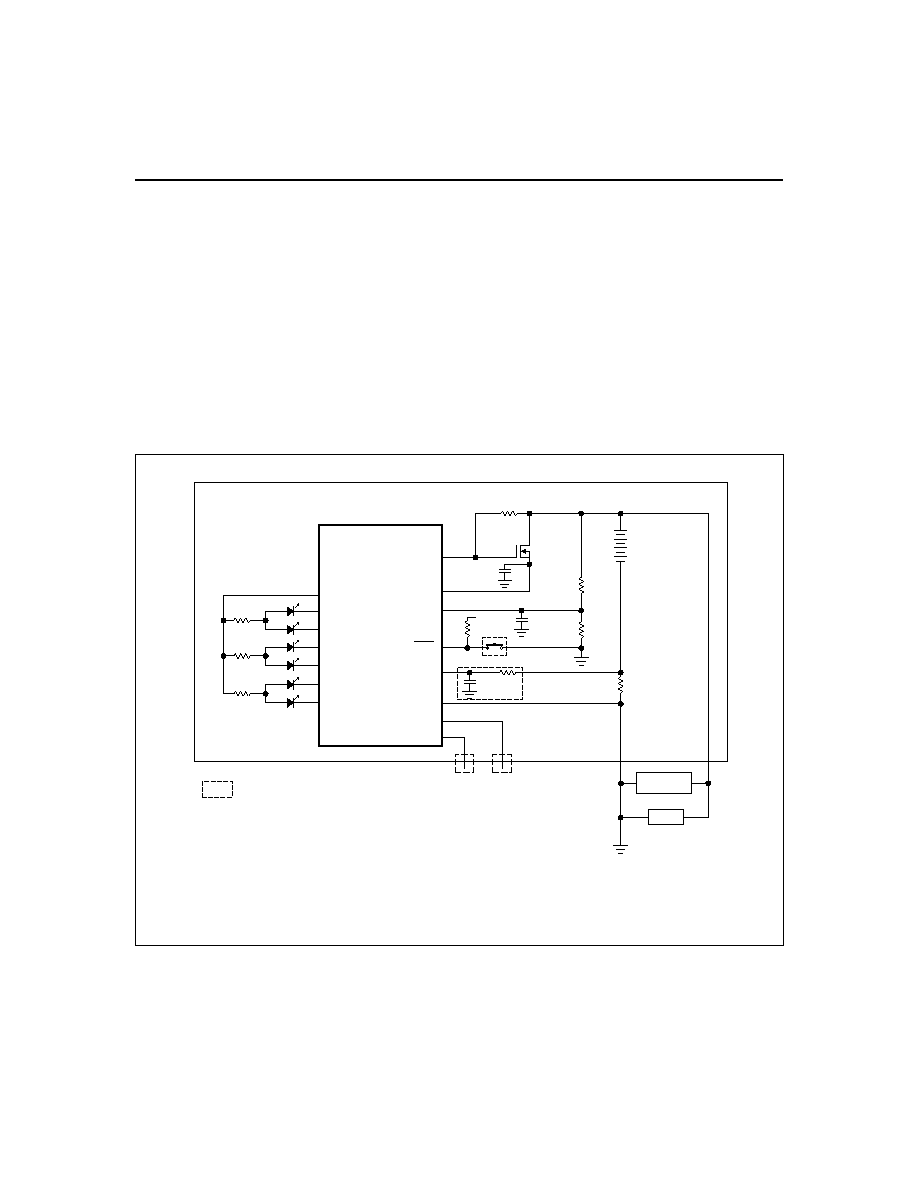 | ÐлекÑÑоннÑй компоненÑ: BQ2010 | СкаÑаÑÑ:  PDF PDF  ZIP ZIP |
Äîêóìåíòàöèÿ è îïèñàíèÿ www.docs.chipfind.ru

Features
Conservative and repeatable
measurement of available charge
in rechargeable batteries
Designed for battery pack inte-
gration
-
120
µA typical standby current
-
Small size enables imple-
mentations in as little as
1
2
square inch of PCB
Integrate within a system or as a
stand-alone device
-
Display capacity via single-
wire serial communication
port or direct drive of LEDs
Measurements compensated for
current and temperature
Self-discharge compensation us-
ing internal temperature sensor
Accurate measurements across a
wide range of current (> 500:1)
16-pin narrow SOIC
General Description
The bq2010 Gas Gauge IC is intended
for battery-pack or in-system installa-
tion to maintain an accurate record of
a battery's available charge. The IC
monitors a voltage drop across a
sense resistor connected in series be-
tween the negative battery terminal
and ground to determine charge and
discharge activity of the battery.
NiMH and NiCd battery self-dis-
charge is estimated based on an inter-
nal timer and temperature sensor.
Compensations for battery tempera-
ture and rate of charge or discharge
are applied to the charge, discharge,
and self-discharge calculations to pro-
vide available charge information
across a wide range of operating con-
ditions. Battery capacity is automati-
cally recalibrated, or "learned," in the
course of a discharge cycle from full to
empty.
Nominal available charge may be
directly indicated using a five- or
six-segment LED display. These seg-
ments are used to indicate graphi-
cally the nominal available charge.
The bq2010 supports a simple
single-line bidirectional serial link to
an external processor (common
ground). The bq2010 outputs battery
information in response to external
commands over the serial link.
The bq2010 may operate directly
from 3 or 4 cells. With the REF out-
put and an external transistor, a sim-
ple, inexpensive regulator can be built
to provide V
CC
across a greater
number of cells.
Internal registers include available
charge, temperature, capacity, battery
ID, battery status, and programming
pin settings. To support subassembly
testing, the outputs may also be con-
trolled. The external processor may
also overwrite some of the bq2010
gas gauge data registers.
1
LCOM
LED common output
SEG
1
/PROG
1
LED segment 1/
program 1 input
SEG
2
/PROG
2
LED segment 2/
program 2 input
SEG
3
/PROG
3
LED segment 3/
program 3 input
SEG
4
/PROG
4
LED segment 4/
program 4 input
SEG
5
/PROG
5
LED segment 5/
program 5 input
SEG
6
/PROG
6
LED segment 6/
program 6 input
1
PN201001.eps
16-Pin Narrow SOIC
2
3
4
5
6
7
8
16
15
14
13
12
11
10
9
VCC
REF
NC
DQ
EMPTY
SB
DISP
SR
LCOM
SEG1/PROG1
SEG2/PROG2
SEG3/PROG3
SEG4/PROG4
SEG5/PROG5
SEG6/PROG6
VSS
REF
Voltage reference output
NC
No connect
DQ
Serial communications
input/output
EMPTY
Empty battery indicator
output
SB
Battery sense input
DISP
Display control input
SR
Sense resistor input
V
CC
3.06.5V
V
SS
System ground
bq2010
Pin Connections
Pin Names
4/95 D
Gas Gauge IC

Pin Descriptions
LCOM
LED common output
Open-drain output switches V
CC
to source
current for the LEDs. The switch is off dur-
ing initialization to allow reading of the soft
pull-up
or
pull-down
program
resistors.
LCOM is also high impedance when the dis-
play is off.
SEG
1
SEG
6
LED display segment outputs (dual func-
tion with PROG
1
PROG
6
)
Each output may activate an LED to sink
the current sourced from LCOM.
PROG
1
PROG
2
Programmed full count selection inputs
(dual function with SEG
1
SEG
2
)
These three-level input pins define the pro-
grammed full count (PFC) thresholds de-
scribed in Table 2.
PROG
3
PROG
4
Gas gauge rate selection inputs (dual
function with SEG
3
SEG
4
)
These three-level input pins define the scale
factor described in Table 2.
PROG
5
Self-discharge rate selection (dual func-
tion with SEG
5
)
This
three-level
input
pin
defines
the
selfdischarge compensation rate shown in Ta-
ble 1.
PROG
6
Display mode selection (dual function
with SEG
6
)
This three-level pin defines the display op-
eration shown in Table 1.
NC
No connect
SR
Sense resistor input
The voltage drop (V
SR
) across the sense re-
sistor R
S
is monitored and integrated over
time to interpret charge and discharge activ-
ity. The SR input is tied to the high side of
the sense resistor. V
SR
< V
SS
indicates dis-
charge, and V
SR
> V
SS
indicates charge. The
effective voltage drop, V
SRO
, as seen by the
bq2010 is V
SR
+ V
OS
(see Table 5).
DISP
Display control input
DISP high disables the LED display. DISP
tied to V
CC
allows PROG
X
to connect directly
to V
CC
or V
SS
instead of through a pull-up or
pull-down resistor. DISP floating allows the
LED display to be active during discharge or
charge if the NAC registers update at a rate
equivalent to |V
SRO
|
4mV. DISP low acti-
vates the display. See Table 1.
SB
Secondary battery input
This input monitors the single-cell voltage
potential through a high-impedance resis-
tive divider network for end-of-discharge
voltage (EDV) thresholds, maximum charge
voltage (MCV), and battery removed.
EMPTY
Battery empty output
This open-drain output becomes high-impedance
on detection of a valid end-of-discharge voltage
(V
EDVF
) and is low following the next application
of a valid charge.
DQ
Serial I/O pin
This is an open-drain bidirectional pin.
REF
Voltage reference output for regulator
REF provides a voltage reference output for
an optional micro-regulator.
V
CC
Supply voltage input
V
SS
Ground
2
bq2010

Functional Description
General Operation
The bq2010 determines battery capacity by monitoring
the amount of charge input to or removed from a re-
chargeable battery. The bq2010 measures discharge and
charge currents, estimates self-discharge, monitors the
battery for low-battery voltage thresholds, and compen-
sates for temperature and charge/discharge rates.
The
charge measurement derives from monitoring the voltage
across a small-value series sense resistor between the
negative battery terminal and ground. The available bat-
tery charge is determined by monitoring this voltage over
time and correcting the measurement for the environ-
mental and operating conditions.
Figure 1 shows a typical battery pack application of the
bq2010 using the LED display capability as a charge-
state indicator. The bq2010 can be configured to display
capacity in either a relative or an absolute display mode.
The relative display mode uses the last measured dis-
charge capacity of the battery as the battery "full" refer-
ence. The absolute display mode uses the programmed
full count (PFC) as the full reference, forcing each seg-
ment of the display to represent a fixed amount of
charge. A push-button display feature is available for
momentarily enabling the LED display.
The bq2010 monitors the charge and discharge currents
as a voltage across a sense resistor (see R
S
in Figure 1).
A filter between the negative battery terminal and the
SR pin may be required if the rate of change of the bat-
tery current is too great.
3
bq2010
FG201001.eps
SEG6/PROG6
SEG5/PROG5
SEG4/PROG4
SEG3/PROG3
SEG2/PROG2
SEG1/PROG1
SR
DISP
SB
VCC
REF
bq2010
Gas Gauge IC
LCOM
VSS
EMPTY
DQ
VCC
C1
0.1 F
µ
Q1
ZVNL110A
R1
RS
RB1
RB2
Load
Charger
Indicates optional.
Directly connect to VCC across 3 or 4 cells (3 to 5.6V nominal)
with a resistor and a Zener diode to limit voltage during charge.
Otherwise, R1, C1, and Q1 are needed for regulation of >4 cells.
The value of R1 depends on the number of cells.
Programming resistors (6 max.) and ESD-protection diodes are not shown.
R-C on SR may be required, application-specific.
VCC
Figure 1. Battery Pack Application Diagram--LED Display

Voltage Thresholds
In conjunction with monitoring V
SR
for charge/discharge
currents, the bq2010 monitors the single-cell battery
potential through the SB pin. The single-cell voltage
potential is determined through a resistor/divider net-
work according to the following equation:
RB
RB
N
1
2
1
=
-
where N is the number of cells, RB
1
is connected to the
positive battery terminal, and RB
2
is connected to the
negative battery terminal. The single-cell battery volt-
age is monitored for the end-of-discharge voltage (EDV)
and for maximum cell voltage (MCV). EDV threshold
levels are used to determine when the battery has
reached an "empty" state, and the MCV threshold is used
for fault detection during charging.
Two EDV thresholds for the bq2010 are fixed at:
V
EDV1
(early warning) = 1.05V
V
EDVF
(empty) = 0.95V
If V
SB
is below either of the two EDV thresholds, the as-
sociated flag is latched and remains latched, indepen-
dent of V
S B
, until the next valid charge.
EDV
monitoring may be disabled under certain conditions as
described in the next paragraph.
During discharge and charge, the bq2010 monitors V
SR
for various thresholds.
These thresholds are used to
compensate the charge and discharge rates. Refer to the
count compensation section for details. EDV monitoring
is disabled if V
SR
-250mV typical and resumes
1
2
second
after V
SR
> -250mV.
EMPTY Output
The EMPTY output switches to high impedance when
V
SB
< V
EDVF
and remains latched until a valid charge
occurs. The bq2010 also monitors V
SB
relative to V
MCV
,
2.25V. V
SB
falling from above V
MCV
resets the device.
Reset
The bq2010 recognizes a valid battery whenever V
SB
is
greater than 0.1V typical. V
SB
rising from below 0.25V
or falling from above 2.25V resets the device. Reset can
also be accomplished with a command over the serial
port as described in the Reset Register section.
Temperature
The bq2010 internally determines the temperature in
10°C steps centered from -35°C to +85°C. The tempera-
ture steps are used to adapt charge and discharge rate
compensations, self-discharge counting, and available
charge display translation.
The temperature range is
available over the serial port in 10°C increments as
shown below:
Layout Considerations
The bq2010 measures the voltage differential between
the SR and V
SS
pins. V
OS
(the offset voltage at the SR
pin) is greatly affected by PC board layout. For optimal
results, the PC board layout should follow the strict rule
of a single-point ground return. Sharing high-current
ground with small signal ground causes undesirable
noise on the small signal nodes. Additionally:
n
The capacitors (SB and V
CC
) should be placed as
close as possible to the SB and V
CC
pins, respectively,
and their paths to V
SS
should be as short as possible.
A high-quality ceramic capacitor of 0.1
µf is
recommended for V
CC
.
n
The sense resistor capacitor should be placed as close
as possible to the SR pin.
n
The sense resistor (R
SNS
) should be as close as
possible to the bq2010.
4
bq2010
TMPGG (hex)
Temperature Range
0x
< -30°C
1x
-30°C to -20°C
2x
-20°C to -10°C
3x
-10°C to 0°C
4x
0°C to 10°C
5x
10°C to 20°C
6x
20°C to 30°C
7x
30°C to 40°C
8x
40°C to 50°C
9x
50°C to 60°C
Ax
60°C to 70°C
Bx
70°C to 80°C
Cx
> 80°C

Gas Gauge Operation
The operational overview diagram in Figure 2 illustrates
the operation of the bq2010. The bq2010 accumulates a
measure of charge and discharge currents, as well as an
estimation of self-discharge. Charge and discharge cur-
rents are temperature and rate compensated, whereas
self-discharge is only temperature compensated.
The main counter, Nominal Available Charge (NAC),
represents the available battery capacity at any given
time.
Battery charging increments the NAC register,
while battery discharging and self-discharge decrement
the NAC register and increment the DCR (Discharge
Count Register).
The Discharge Count Register (DCR) is used to update
the Last Measured Discharge (LMD) register only if a
complete battery discharge from full to empty occurs
without any partial battery charges.
Therefore, the
bq2010 adapts its capacity determination based on the
actual conditions of discharge.
The battery's initial capacity is equal to the Programmed
Full Count (PFC) shown in Table 2. Until LMD is updated,
NAC counts up to but not beyond this threshold during
subsequent charges. This approach allows the gas gauge to
be charger-independent and compatible with any type of
charge regime.
1. Last Measured Discharge (LMD) or learned
battery capacity:
LMD is the last measured discharge capacity of the
battery. On initialization (application of V
CC
or bat-
tery replacement), LMD = PFC. During subsequent
discharges, the LMD is updated with the latest
measured capacity in the Discharge Count Register
(DCR) representing a discharge from full to below
EDV1. A qualified discharge is necessary for a ca-
pacity transfer from the DCR to the LMD register.
The LMD also serves as the 100% reference thresh-
old used by the relative display mode.
2. Programmed Full Count (PFC) or initial bat-
tery capacity:
The initial LMD and gas gauge rate values are pro-
grammed by using PROG
1
PROG
4
. The PFC also
provides the 100% reference for the absolute dis-
play mode. The bq2010 is configured for a given ap-
plication by selecting a PFC value from Table 2.
The correct PFC may be determined by multiplying
the rated battery capacity in mAh by the sense re-
sistor value:
Battery capacity (mAh) * sense resistor () =
PFC (mVh)
Selecting a PFC slightly less than the rated capac-
ity for absolute mode provides capacity above the
full reference for much of the battery's life.
5
bq2010
FG201002.eps
Rate and
Temperature
Compensation
Temperature
Compensation
Charge
Current
Discharge
Current
Self-Discharge
Timer
Temperature
Translation
Nominal
Available
Charge
(NAC)
Last
Measured
Discharged
(LMD)
Discharge
Count
Register
(DCR)
<
Qualified
Transfer
+
Rate and
Temperature
Compensation
Rate and
Temperature
Compensation
Temperature Step,
Other Data
+
-
-
+
Inputs
Main Counters
and Capacity
Reference (LMD)
Outputs
Serial
Port
Chip-Controlled
Available Charge
LED Display
Figure 2. Operational Overview




